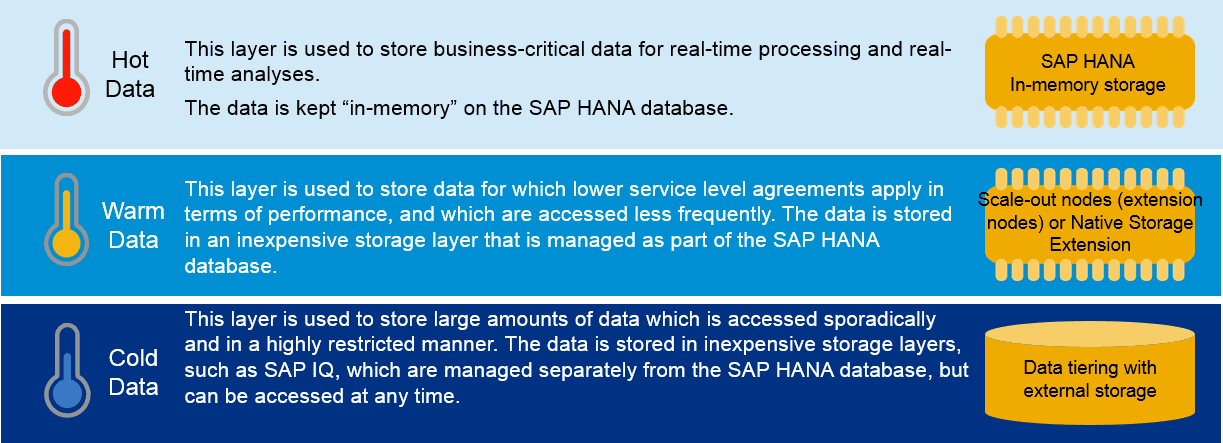Businesses evolve over time. They expand, scale up, procure new systems, go through mergers and acquisitions, ditch old processes, adopt new ones, build products, enter new regions, and migrate. Every change like this impacts the process and data environment, making it difficult to manage the data volumes in both transaction and data-warehouse systems.
Also, they accumulate a huge chunk of business data to fulfill their daily operations and during the real-time reporting or analysis processes.
Considering it all, your organization’s data is bound to grow exponentially. Data Growth will eventually increase the storage costs and have the huge impact on the system performance.
SAP BW/4HANA lets its users do data tiering optimization (DTO) capability to prevent problems. Read ahead and learn what it is.
Multi-Temperature Data Management
Businesses have all type of data. Some data is used rarely while other is required frequently. If you could dynamically move the rarely-accessed data to a low-cost and low-speed data storage for archiving, it will reduce data storage cost heavily and positively for your organization, isn’t it?
Multi-temperature data management makes it possible.
It classifies data in different storage areas according to the utility and usage frequency.
Data Tiering in SAP BW/4HANA
In SAP BW/4HANA, if you want to perform Multi-Temperature Data Management, data tiering, i.e. create data tiers, has to be the first step of yours. Criteria for creating data tiers can be (but not limited to):
- Data Type
- Usability and Criticality for Operations
- Frequency of Accessing the Data
- Data Security Needs
Data Tiering Optimization in SAP BW/4HANA enables customers to set all the storage options and configure tiers using a central UI (user interface)
It is an important process for business data, as it helps organization in streamlining their operations, administering the data, and updating the storage. It not only optimizes the memory footprint of data but reduces the total cost of ownership (TCO) effectively.

Source – SAP
Standard Tier (hot):
SAP HANA stores hot data in its in-Memory.
Extension Tier (warm):
Extension node is used for data storage purpose.
External Tier (cold):
External Storage space, such as SAP IQ, Hadoop or SAP Vora, is used for data storage instead of filling up the SAP HANA database.
Standard and Extension tiers form a logical unit and are available for SAP users in your organization almost immediately. However, external tier is located out of your SAP deployment and required you to deploy security arrangements to make it non-vulnerable.
Data Tiering Optimization (DTO) for Advanced Data-Store Object
DTO helps customers in data classification in SAP BW/4HANA. You can determine the cost and performance needs of your business data and shift it to warm, hot, or cold data storage accordingly.
There are few prerequisites to enable DTO through Advanced DSO.
- The Data Store object (advanced) must have at least one key field.
- To store data in the external layer, partitions must be defined.
- SAP BW/4HANA 1.0 Support Package 4 or above.
Implementation Procedure
- From “General Tab” of ADSO, under “Data Tiering Property” – select the data tiering type standard layer (hot), extension layer (warm) or the external layer (cold).
- Based on the selected data tiering option, choose the method to transfer the data to specified storage layer i.e. using partition or by object type. To store data in the external layer, partitions must be defined first.
- Object Level Temperature Maintenance – It refers to entire data set from ADSO.
- Partition Level Temperature Maintenance – Partition must be created based on time characteristics (0CALDAY, 0CALMONTH etc.) to break down the ADSO data volume into smaller data sets.
- Partitions can be created from the settings Tab of ADSO by specifying lower and upper limit for specific time characteristic. I.E. If we select 0CALYEAR, we can specify lower and upper limit year wise 2010 to 2011, 2011 to 2012 and so on.
- Using RSOADSODTOS T-Code, we can further define temperature for individual portioned year (or time characteristic) based on our requirement.
- DTO job shifts the data to its allotted storage space at pre-defined time intervals. Further, you may automate these jobs using the process chain type – Adjust Data Tiering.
Conclusion
Multi-Temperature Data Management is an efficient way to classify organization data and save storage cost without putting your business data at risk. With SAP BW/4HANA, the process becomes effortless once data tiers are configured by SAP experts. Need our help in it? We are immediately available. Contact SAP BW/4HANA specialists at Stridely Solutions today.


